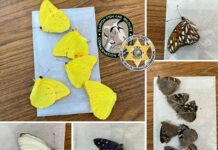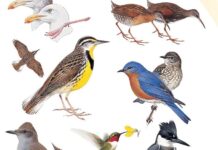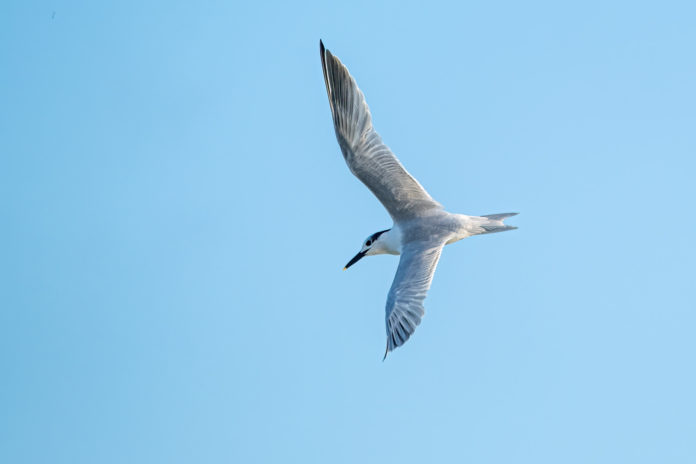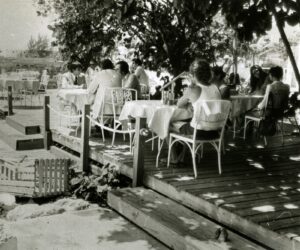I was sitting on the cement wall down at Rest Beach, watching the Sandwich terns, when the band started up. It looked to be a New Orleans-style second line – a trombone, a trumpet, a tambourine, a couple drums, a neon sousaphone, an electric guitar, and at least three types of saxophone – a funeral or memorial service of some kind.
As you often do in a small town, I wondered if it was for anyone I knew, at least in passing.
The band, and the crowd that mixed in with them, made their way over the elevated part of White Street Pier – the section they’d added a while back so the water could flow through and keep the sargassum from building up, and thus keep the neighborhood from becoming too acridly fragrant in the warmer months – and then continued out into the wider expanse of the pier. I was expecting them to play something of a dirge, but the song was pretty up-tempo, a little jazzy, something I didn’t recognize, that faded the further they went out on the pier.
Whoever’s service it was, I wondered if they got what they wanted out of their life, and hoped that they did.
Meanwhile, the Sandwich terns went about their business.
Sandwich terns don’t necessarily throw themselves at life, but they do throw themselves at lunch. Also, dinner, breakfast and the occasional between-meal snack. They aren’t one of those bird species that wander around, pecking at things. And they don’t freeze like statues, waiting to stab at something with their bill. They are plunge divers, committing their whole selves to falling out of the sky with the intention of nabbing a single fish – usually something about an inch and a quarter long. According to the literature, on average they are successful three out of four times.
They are smallish birds. With their wings folded they are about the length of a large meatball sub. (This is not where their name comes from.) They are relatively subtle and quiet about things, so sometimes it is difficult to notice how full-contact their lives are.
I’d actually come down to try and photograph them diving and was finding myself a little frustrated. Other plunge divers are easier to track. A brown pelican, for instance, will start to do a barrel roll when they dive, sometimes hitting the water sideways, like a tomahawk, sometimes angling in and hitting the water almost inverted. An osprey will hover, flap, then rise up a little bit, before falling down on its prey. Both species face into the wind before they do it.
Sandwich terns will also face into the wind, and sometimes hover. And it’s pretty easy to track them to that point with a long lens. But then they will just drop out of the frame, faster than you, or at least I, can follow. They don’t give any warning, as far as I can tell, they just fall. Sometimes you might catch them rising up out of the water again, but mostly they just lose you. Or at least me.
After a while I gave up with the camera and decided to just watch to better understand the dynamics of their dives.
I counted a total of nine of them at one point, all working the same area. They seemed to pay no attention to one another, flying on different vectors, switching zones, shifting around in the air like a poorly organized soccer team. Sometimes one would give a call that sounded similar to a smoke alarm with a low battery.
Occasionally one would dive, hit the water, splash, then rise up, I hoped with a fish in their bill. More often than not, though, they would start a dive, then break off part way and abandon it, circling around for a second as if they had something better to do.
The thing that got me about their dives when they did make them was how fast they were. While pelicans follow a path similar to the arc of a rainbow, and osprey hit with something close to Superman drama, the Sandwich terns just dove wings out, almost straight down, like a fast-forwarded kamikaze dive. It was lightning-fast, deftly efficient, and as visually deceptive as a game of three-card monte.
A trio of brown pelicans worked the same bit of ocean. They seemed to be diving five or 10 times as often as the terns.
I started to wonder why there was such a difference in their rates of diving. Looking it up later, a Sandwich tern, when feeding, tends to dive slightly more than twice a minute. With these birds it seemed more like once every five minutes.
It had been blowing for days, and the water close to shore was pretty cloudy – that inharmonious beige-suspended-in-blue color we get down here. So visibility probably had something to do with it. Possibly it was the fact that the average size of the fish a brown pelican will consume is about two-and-a-half inches – twice the size of the ones Sandwich terns consume.
But I also started to think about their different hunting techniques, as well as the birds’ physical forms. The brown pelican’s methods are pretty similar to fishermen using a seine net. They basically hit the water open mouthed, aiming at whole groups of fish, capturing as much as 20 pints of fish-filled water in their gullet, then slowly draining the water out until they are left with nothing but fish.
Anyone who’s ever witnessed a peregrine falcon maraud into a flock of birds will see that they don’t chase the group as a whole, but instead pick out one individual and aim for it. Sandwich terns, it would seem, need to employ a similar surgical precision, and maybe picking out an an inch-and-a-quarter long fish in cloudy water from 20 feet up was not as easy as it seemed to the casual observer.
While I wondered about all this, the second line started up again, getting louder as they made their way back down the pier, playing what I believe was the same song again, but then switching to something new and a little more up. They kept playing until they made it to the parking lot, where people hugged and talked for a while before they slowly dispersed.
The terns and the pelicans kept feeding, or at least trying to. I watched as the light halved itself, then halved itself again, as the people on the pier turned to silhouettes, then shadows. I was trying to catch that moment when the birds called it a night. I was still watching when I realized they already had.


















